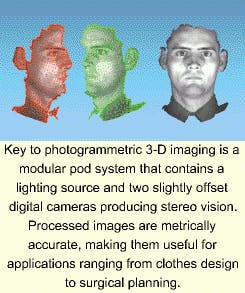A UK government-funded research partnership has developed a novel range of three-dimensional (3-D) imaging applications, and a new company has been spun out that will take the technology to the market place in a range of application areas. Other companies within the partnership are planning to exploit the technology in their own areas.
In 1997, the government set up four Faraday Partnerships to provide a focus for industry links with a research base in specific technology areas. The 3D-MATIC group (3D Multimedia Applications and Technology Integration Centre), centered on the Department of Computing Science at the University of Glasgow, was set up to enable commercial companies to gain access to advanced 3-D digitization technology and its applications, with a view of bringing it into the marketplace. The project also aims to improve the technology in this field. It received an initial injection of £1 million ($1.6 million) from the Engineering and Physical Sciences Research Council (Swindon, England).
The key technology in the 3D-MATIC project is a form of photogrammetry. Two images taken from two slightly offset cameras are compared to develop 3-D images (see figure). Software development has focused on identifying the correlation between the images so they can be compared, generally by taking each pixel, looking at its neighbor, and using the pattern to discover the corresponding point in the scene in the other picture. Having established the correlation, the software then looks for the differences: the greater the offset between the pixels representing the same point in the scene, the closer that point is to the position of the cameras.
The equipment is based on a modular pod system, with each pod containing two digital cameras—producing stereo vision—and a lighting source. Multiple pods are used for larger objects. The system can image the surface of an object in a fraction of a second. The visual information captured is then processed by a standard PC and used to produce models with an accuracy of 0.5 mm. The 3-D models can be stored and processed as variable-mesh polygons that integrate with a variety of third-party 3-D applications and can be combined with image-rendering files to create a high-resolution digital photo-realistic record of what the surface looks like in three dimensions. The data can be exported to a variety of other software packages, including AutoCad, 3Dstudio, and virtual-reality applications. It is also possible to achieve shape-only recording in real time thus allowing 3-D snapshots to be captured of bodies in motion.
3D-MATIC has found that 3-D sensing based on low-cost digital cameras opens up a range of cost-sensitive application areas. One big market is likely to be in the use of 3-D body scans to help people to visualize and buy clothes over the Internet. Anthropometry data from 3-D body scanning is also important for everything from car design to interior space evaluation. There are also medical applications of whole and partial body scanning.
3D-MATIC partnership director Paul Siebert says, "I believe that all hospital photographic rooms in the near (five-year) future will capture 3-D images of patients as opposed to 2-D images. The 3-D data affords quantitative analysis and is unambiguous in terms of metric information. Applications will be in the area of surgical planning, clinical assessment, and clinical audit."
An interesting market in digital media production has also been identified. 3D-MATIC's photogrammetric technique offers benefits for both post-production correction of errors from traditional movie shoots and also for the addition of special effects. The basis of this capability lies in the use of image sequences from a single camera, rather than image pairs from adjacent cameras, to construct a 3-D image. By recovering the 3-D appearance of objects in a movie sequence, wholly novel image repair processes become possible in post-production, including re-lighting, and re-colorization. In addition synthetic actors can be generated who will be indistinguishable from their real counterparts, which is especially useful for gruesome special effects. There are also 3-D TV applications in which a modified TV set could compute a 3-D freeze frame from an ordinary broadcast video data stream. The CREATEC division of the National Film and Television School at Ealing Studios (London, England) is involved in the partnership.
The partnership has recently spun out a company to commercialize some of the 3-D imaging technology. The new company, C3D, is based in Glasgow and has an exclusive license to the technology for human body scanning in particular application areas. Siebert predicts that more companies will be formed in the near future as more applications are found. "The idea is to get this technology spun out as much as possible," he commented.
Bridget Marx | Contributing Editor, UK
Bridget Marx was Contributing Editor, UK for Laser Focus World.
